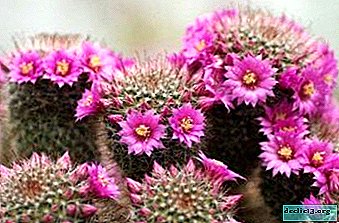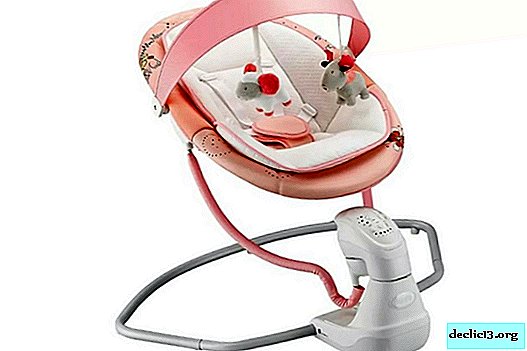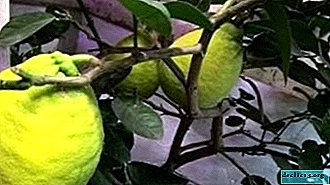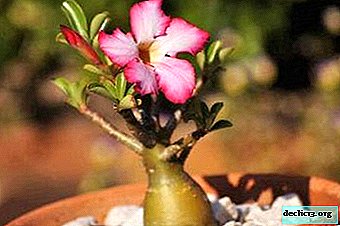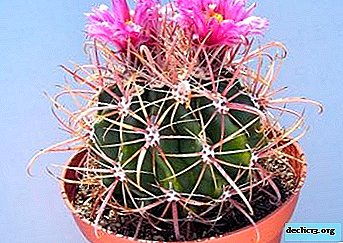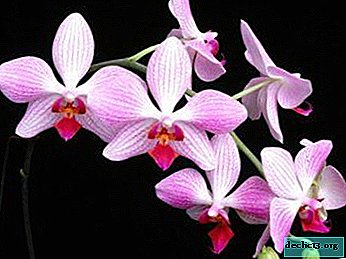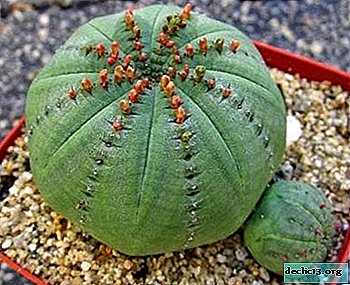What does a baby look like on an orchid and how to care for her? Tips for gardeners
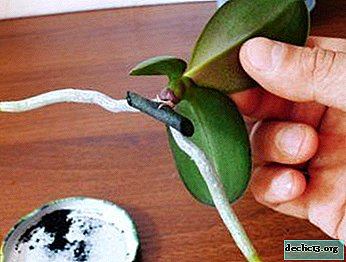 Orchid is a truly beautiful flower, which is very popular among gardeners.
Orchid is a truly beautiful flower, which is very popular among gardeners.
Depending on the variety, the flowers can be of different colors: red, pink, lilac, orange, white and many others. etc. In nature, there is even a black variety.
What are babies or children of an orchid, what does it look like when a flower starts a shoot on a trunk, are there 3 shoots at a time? You can read about all this in our article.
What it is?
Orchid children are lateral young processes that can appear on the stem of a plant, at the roots, or on a peduncle.
What does it look like?
Children are miniature plants that have their own stem, leaves and root system. Most often, they appear on their own, with proper care for the orchid.
Role in flower life
Children play an important role in the life of orchids. We can say - this is their continuation. Reproduction by children is the easiest and fastest way to propagate orchids. The most popular varieties that propagate in this way are Phalaenopsis and Dendrobium.
What parts are formed on?
Children can appear on the following parts of the plant:
- On the peduncle. After the orchid fades, a young shoot may appear on the peduncle.
- At the roots. Most often they appear at the roots. Separate them with extreme caution, because you can damage the roots of an adult plant.
- On the stem.
You can find out more about how to understand that children grow on an orchid here.
REFERENCE! Children on the stalks of orchids are formed in the zone of fading of the growth point of the plant. After the death of the mother plant, it will grow.How many pieces can appear at a time?
On the peduncle of one plant, one or more children can form simultaneously. They can be located both in the middle of the peduncle and at its end. As a rule, most often appears one at a time.
Photo





How arises?
After the orchid fades, do not rush to remove the peduncle. It is likely that one or more tiny processes will appear from a sleeping kidney.
At first they are very small in size. They have small leaves, and as they grow, you can notice the appearance of round seals at the base. This is starting to poke roots.
Do not rush to separate the children from the mother-plants. The processes that form at the roots should be separated very carefully, because there is a risk of damage to the root system of the flower.
Sometimes babies form right on the stem of an orchid. Separating them is not recommended. They do not have their own roots, and when trying to separate, there is a possibility of the death of the whole plant.
How long does it take to get separated?
Children grow up for a very long time. Before proceeding with the separation of the young from the mother plant, you need to let the roots form. Usually, it is possible to separate the processes only after they have grown 2 to 4 roots, the length of which should be at least 5 cm. From the moment of her appearance and until the separation of the baby from the "mother", at least six months pass. Sometimes it takes a much longer period of time.
IMPORTANT! In some varieties of orchids, for example, phalaenopsis, the roots on the process may not even appear. In such cases, it is necessary to wait until 4 to 5 leaves appear on the baby, then cut it and root.When to wait for the appearance?
After the orchid has faded, the peduncle cannot be completely removed. It simply needs to be shortened, after which at least 2 cm should remain above the "sleeping" kidney. For the formation of the baby, the following conditions are necessary:
- the end of the flowering period of orchids;
- sufficient lighting after flowering;
- relatively high air temperature (25 - 30 degrees).
For in order to get quality shoots, it is necessary to carry out proper care for the mother plant. As a rule, they appear in the warm season, most often in the summer. Read a detailed guide on growing orchid children here.
Very often, the appearance of children is provoked by the threat of the death of an orchid. For example, if the roots of a plant rot and growth stops, it is during this period that one or more children are formed.
Why does not give offspring?
 Sometimes, even a completely healthy orchid may not produce offspring. The reasons may be different. Let's consider some of them:
Sometimes, even a completely healthy orchid may not produce offspring. The reasons may be different. Let's consider some of them:
- Temperature condition. If it looks healthy, a green plant does not bloom, and, accordingly, does not let out children, then the air temperature is too low for this. To awaken a "sleeping" kidney, you need a temperature difference: at night + 15 degrees, in the afternoon + 25 - 30 degrees.
- Lighting. In order for the orchid to produce offspring, it needs good lighting.
- Lack of nutrients in the soil. The soil is quickly depleted and this may be the reason for the absence of children in the orchid. An adult plant must be fertilized once every 14 days. Exceptions are diseased plants and those that have recently been transplanted. They feed the orchid both by watering the soil with liquid fertilizers, and by spraying the leaves with sprays.
- Pot. It is very important that the orchid grows in the “right” pot. It should fit its size and be equipped with a good drainage system.
What to do if it does not grow?
If the baby does not grow, you should look for the causes of this fact and eliminate them. The first step is to take care of ensuring favorable conditions for this:
- optimal temperature conditions;
- proper top dressing and watering;
- adequate lighting;
- the "right" pot.
It is worth noting that sometimes even if all the necessary conditions are met, the children do not appear. In such cases, artificial stimulation is performed. To do this, use a hormonal cytokinin paste. It is applied to a "sleeping" kidney, which is previously cleaned of scales. This procedure is recommended in the spring.
How to care?
The appearance of the baby is an important stage in the life of the plant. At this time, it is necessary to provide quality care for him. What you need to pay special attention to, we consider below:
- Watering. Watering an orchid, on which one or several children appeared, is necessary in the usual mode. It consists in irrigation as the soil dries. High-quality irrigation can be carried out with an interval of 5 to 10 days.
- Top dressing. It is necessary to feed the orchid with special fertilizers, which can be purchased at any flower shop. Fertilizing is necessary at the end of the flowering stage, with every second watering.
How to take a shoot?
 When about 3-4 leaves are formed on the baby and the roots are strong, it is necessary to separate it from the mother plant. For this procedure, you will need the following:
When about 3-4 leaves are formed on the baby and the roots are strong, it is necessary to separate it from the mother plant. For this procedure, you will need the following:
- scissors, knife or pruner;
- cinnamon or activated carbon;
- latex gloves;
- alcohol (for disinfecting the instrument).
Cut the baby that formed on the peduncle must be scissors disinfected with alcohol. In this case, it should be cut together with part of the peduncle (1 cm). The cut should be treated with cinnamon powder or powdered activated carbon.
Sometimes a peduncle is formed on an unrefined baby. In such cases, it must be removed, since it will take away the strength of the young shoot.
When separating the baby, which appeared at the roots, it is necessary to remove the upper part of the substrate and examine the roots. If they are sufficiently developed, it can be cut.
How to stimulate the roots?
If the roots grow very slowly, you can stimulate their growth.
- To do this, wrap the baby’s base with moist moss and tie it with thread.
- To maintain optimal humidity, you can wrap it in a plastic bag or cling film.
- In addition, the plant should be in good light and high temperature.
For more details on how to grow the roots of a baby orchid, read our article.
Problems
In the process of growing orchids, children often have any problems. Consider the main ones:
- For a long time babies do not appear. To eliminate this problem, it is necessary to create favorable conditions for their appearance or to stimulate with cytokinin paste.
- On a sick orchid, children began to appear. First of all, you need to cut the peduncles and put in water with activated carbon. It is recommended to change the water once every 3 days. When the flower stalks dry, the children need to be transplanted to moss. The mother plant is resuscitated.
- The flower stalk has withered, and the baby has not yet gotten its roots. In this case, you need to cut the shoot and plant it on the moss, and remove the peduncle from the plant. During this period, fertilizing with fertilizers is necessary. The recommended dose for an adult orchid is reduced by 3 times.
Transplant Instructions
After cutting the baby from the orchid, it needs to be transplanted into a separate container for rooting. There are several ways to root:
- Air. A drainage is placed in a plastic cup with the holes made, and moss is placed on top of it. In the upper part of the glass, a support is made on which the baby lies, which does not touch the moss. From above, the glass is covered with another larger glass. Moss moisturize and air daily.
- Greenhouse. To equip a small greenhouse, a transparent container is taken. It can be a glass jar with a lid or a plastic cup. Drainage is laid at the bottom of the tank, and chopped pine bark is placed on top of it. It must first be boiled. A baby is placed in the mass of the cortex and covered with a lid. The greenhouse is aired daily.
 Disembarkation Instructions:
Disembarkation Instructions:
- After the final rooting of the baby, it needs to be planted in a pot. It should not be large, with enough drainage holes.
- Drainage is laid at the bottom - previously boiled pebbles.
- Then crushed dried pine bark is poured.
- Having placed the baby more conveniently, the substrate (moss, charcoal, bark and peat) is carefully poured.
- If the roots do not completely fit into the pot, it is allowed to leave them at the top.
- Next, you need to care for an adult plant.
With the provision of favorable conditions, proper care, a chic orchid can be grown from a baby. In just 3 to 4 years, it will turn from a miniature process into a lovely flower that will bloom to the delight of others.
Interesting video
Watch a video about caring for children and teenagers of orchids:

